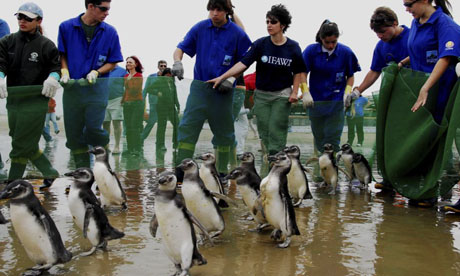
AFP, 3 October 2008 - Earth's animal and plant species are vanishing at unprecedented rates, evidence that the planet is facing a tsunami of mass extinction, experts gathering for a global conservation conference next week have warned.
Whether through habitat loss, pollution, hunting, or indirectly by global warming, humans are squarely to blame for what may be the first major die-off in 65 million years, they say.
From Sunday, more than 8,000 ministers, UN officials, NGOs, scientists and business chiefs will brainstorm for 10 days in the Spanish city of Barcelona on how to brake this loss and steer the world onto a path of sustainable development.
The World Conservation Congress, held every four years, will also release an update on Monday of the famous "Red List", deemed the global standard for conservation monitoring.
It will include the most comprehensive study ever made on the survival status of Earth's more than 5,000 mammals species.
The new biodiversity "bible" is the fruit of 1,700 experts, and scientists who took part in the effort say it will make for grim reading.
The 2007 edition already shows more than a third of 41,000 species surveyed are facing extinction: a quarter of all mammals, one out of eight birds, one out of three amphibians, and 70 percent of plants.
Our closest evolutionary cousins, primates, are especially vulnerable.
Hunted for food and traditional medicines, their habitat dwindling, more than 70 percent of known species in Asia, for example, are under threat.
Science has identified more than 1.9 million species to date. If microbial organisms are included, this is probably only a tenth of the life forms on Earth.
"Biodiversity is disappearing at an accelerated rhythm and we have to act quickly to slow and prevent the extinction crisis," said Julia Marton-Lefevre, director general of the International Union for Conservation of Nature (IUCN), which organising the October 5-14 congress.
With 11,000 volunteer scientists and more than 1,000 paid staff, the IUCN runs thousands of field projects around the globe to monitor and help manage natural environments.
"No species is superfluous -- each one is the product of millions of years of evolution and plays a role in the ecosystem," explained Wendy Foden, head of the IUCN's climate change and species programme.
There are many reasons to protect the diversity of life on Earth, under pressure from loss of habitat, pollution, climate change and over exploitation, scientists say.
One is the sheer scope of the change underway.
"The evidence is overwhelming -- and we have really good data now -- that what we are seeing is probably a mass extinction," the sixth in 450 million years, said Michael Hoffman, a mammal expert at IUCN who worked extensively on the Red List.
The current pace of dieoff is 100 to 1,000 times higher than the so-called "background rate" of extinction -- the average rate, over millions of years, at which species bite the dust.
"Species extinctions across all these groups will have very far-reaching consequences on human beings," he said.
Large and small mammals, for example, play critical roles in the regeneration of forests and savannahs by spreading plant seeds through their excrement. Forests, in turn, help blunt the impact of global warming.
Marine coral reefs, dying off due to pollution and acidification driven by climate change, support thousands of species of fish upon which hundreds of millions of humans depend for food and livelihood.
"If you have no coral reefs, you have no fish," Hoffman said.
Many plant species provide valuable medicines. Others can act as a buffer against natural disasters.
Many lives could have been saved in the Asian tsunami of 2004 and the typhoon that struck Myanmar last May if protective coastal mangroves had not been ripped up.
"There should also be a moral obligation to conserve biodiversity, if not for ourselves then for future generations," said Hoffman.
He said he was just back from a field trip in the Kruger National Park of South Africa, where he witnessed awe-struck children seeing giraffes and elephants close-up for the first time.
"We should want our children, and their children, to be able to see these giants walking the Earth," he said.
This article is reproduced with kind permission of Agence France-Presse (AFP) For more news and articles visit the AFP website.




